As the most intuitive window to experience automotive intelligent technology, intelligent cockpit is steadily moving towards the deep end of “intelligence”, and automakers have worked to deploy intelligent cockpit functions they regard as the differentiated selling points of their vehicle models.
In 2023, OEMs released a number of innovative concept models and new models for sale, especially models of emerging brands such as Xpeng, ZEEKR, Galaxy, LUXEED, NEVO, Avatr and Jiyue. New technologies, new scenarios and new modes including diversified displays, new UIs, comfortable intelligent seats, panoramic sound effects, ambient lights, and intelligent surfaces spring up.
Display and interior design are deeply integrated to emphasize emotional resonance with users.
Automotive display, as the intelligent cockpit component users can perceive most easily, has become an important means for automakers to offer a differentiated experience for users. In 2023, cockpit display design shows the trend of multi-screen, large screen, diversification and technology.
First, the number of models with large integrated displays is increasing. In recent years, Ford, Lincoln, Cadillac, ARCFOX, IM, Roewe, Jiyue, Geely Galaxy and many other auto brands have launched models with integrated displays which are tending to be bigger, for example, Geely Galaxy E8 is equipped with a 45-inch 8K integrated display, Jiyue 01 with a 35.6-inch 6K integrated display, Cadillac LYRIQ with a 33-inch integrated display, Buick E5 with a 30-inch 6K integrated curved display, and Ford EVOS with a 27-inch 4K integrated display.

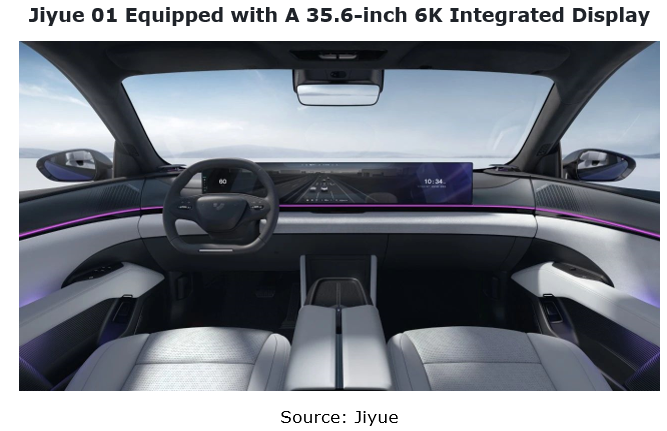
Second, the conventional cluster screen is replaced by the design and display layout. In the trend for extremely simplified design, there is a design mode in which the cluster screen is replaced. On the market Tesla Model 3 and Model Y are the first models without clusters. Their cluster functions are mainly concentrated on the left area of the center console display to expand the visible field of view, improve user experience, and embody intelligence.
In addition to Tesla, many models launched in 2023 adopt the center console + HUD design without common clusters. For example, Li Auto’s L Series models, Changan NEVO A07, Deepal S7, Geely Livan 7, and HiPhi Z all have HUDs without clusters. As intelligence level gets higher and display technology matures and advances, display and interior will be further integrated, and cluster screens of more models will be cancelled or replaced.
Deepal S7 adopts the embracing interior design like a luxury yacht, highlighting luxury and comfort. Equipped with a 15.6-inch intelligent steering screen and AR-HUD but without cluster, it focuses the front view of the driver upward to improve safety by deeply integrating intelligent driving and vehicle systems.
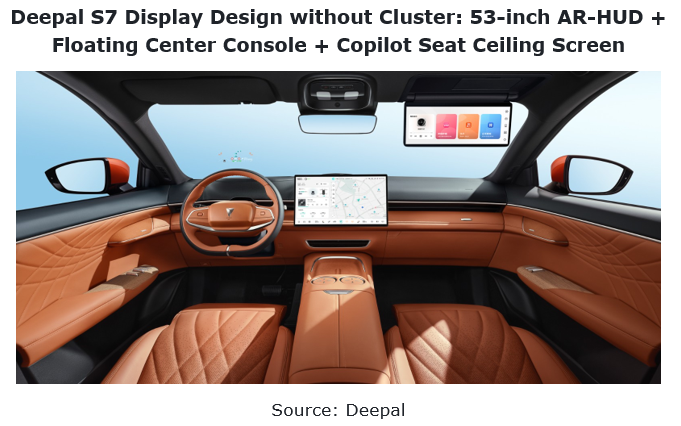
Changan NEVO A07 adopts an unconventional design style of "Emotional Island Floating Interior Space". The common cluster at the driver’s seat is canceled and replaced by a 50-inch AR HUD and a floating center console screen.

As display and interior tend to be integrated and technology matures, display design concepts such as holographic display, projection, invisible screens and non-screen design have appeared.
In 2023, BMW released i Vision Dee, a vision vehicle that enables digital emotional interaction, demonstrating BMW’s vision for the future digital experience inside and outside the car. There are no physical buttons in the car. By using Shy Tech, the HUD system replaces the conventional LCD to create a mixed reality interactive interface. Using shy-tech sensors on the instrument panel and the five-level touch slider projected on the center console, drivers can determine the content and area displayed on the HUD system (which can span the entire windshield).
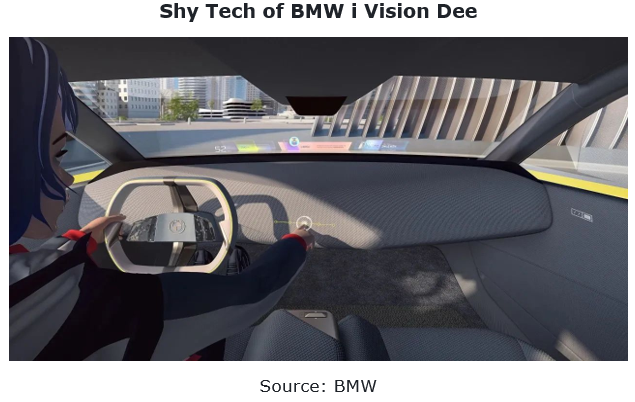
In addition to conventional cluster, center console and copilot seat display, there are a variety of diversified display products such as copilot seat ceiling screen, center console ceiling screen, lifting screen, sliding screen, privacy screen, and light field screen.
Based on visual design upgrade, exploration of UI gets deeper in terms of 3D HMI and custom settings.
As automotive display technology continues to mature, automotive human-machine interfaces (HMI) are being upgraded, and elements such as zero-level interaction, card-style design and flatness have been widely used. With the enrichment of smart car functions and contents, the future interface interaction is becoming more concise, 3D intuitive, and personalized.
As 3D HMI penetrates into the automotive field, the application of 3D HMI is no longer limited to 3D virtual assistants and 3D car models, and it finds broader application in 3D AR-HUD, 3D map navigation and driving assistance scenarios, seamless 3D scene functional transition (one shot), and 3D immersive scene space.
3D HMI solutions gradually penetrate from some functions to the system desktop and even the all-scenario function solution design. The intuitive and three-dimensional interactive experience not only improves the convenience and safety of the driver's operation, but also provides high-quality entertainment experiences.
In 2023, Flyme Auto, an IVI system jointly built by Meizu and Geely, was equipped with a 3D car model desktop. It can realize seamless transition between different scenes, break through the application boundary, reduce the sense of separation between the desktop and the application, present the environmental elements outside the car in real time and live, and provide common settings according to different scenarios, thus enhancing user experiences from vision to interaction to comprehensive live functions.
Based on 3D engine rendering, the desktop of Flyme Auto is designed with 'Ruran Engine', which shows the passage of 24 hours a day through real-time rendering and integrates the weather system into it, so that users can immediately feel the unbounded experience of breaking the boundaries between digital world and reality. In addition, its air conditioning and charging interfaces are designed with 3D particle dynamic effects to enhance the emotional value of the product, which is vivid.
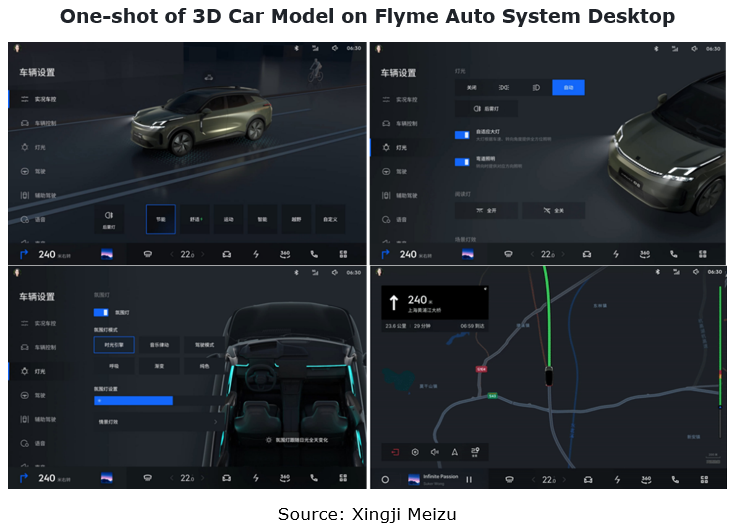
To meet personalized needs, the IVI UI also keeps expanding. At present, multiple models offer customizable options in IVI UI settings, evolving from originally a few customizable options to the personalized settings that are customizable on multiple function pages.
In October 2023, Xpeng released Xpeng X9, its first MPV equipped with a new smart cockpit XOS and a multi-task architecture which supports independent operation of multiple tasks. The new XDock supports custom editing, places frequently-used functions required in different seasons/scenarios in the Dock bar to achieve zero-level interaction between commonly used functions.
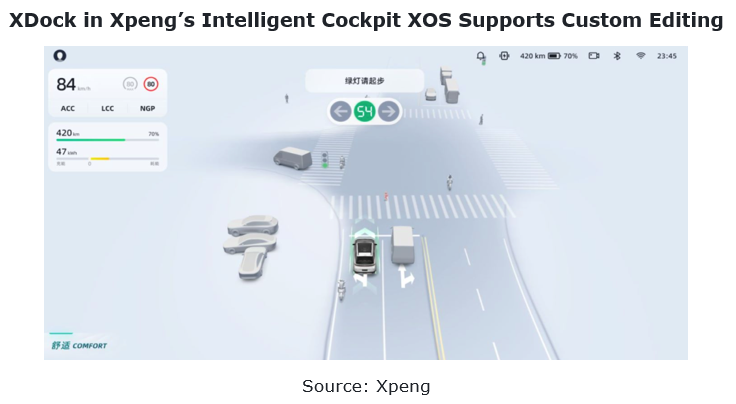
In 2023, the IVI desktop of Lynk & Co 09 equipped with LYNK OS N features super customization. Users can define desktop cards, first-level menus of vehicle settings, vehicle control pages and Dock bar cards as they like.
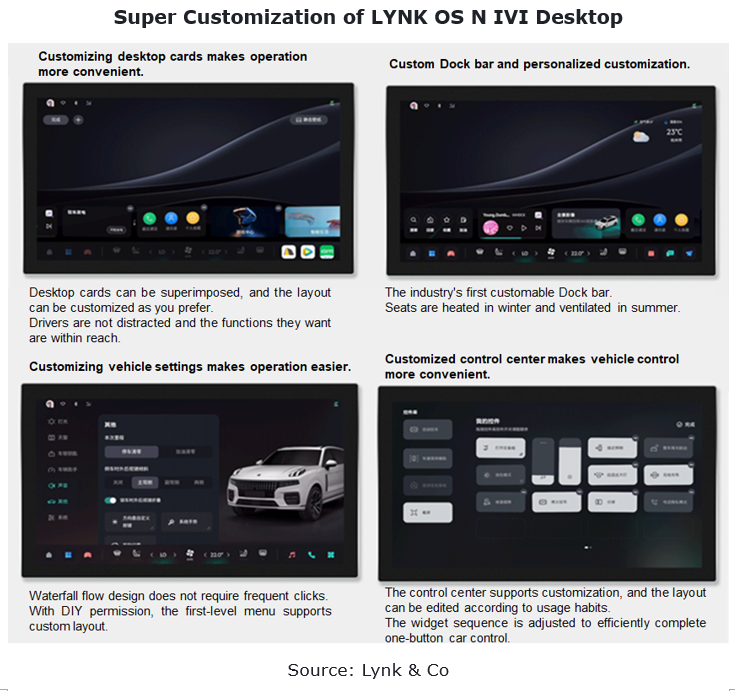
In addition, the IVI UI has begun to resemble that UI of mobile phones and tablet PCs. For example, split screen is used in multiple models, reducing user learning costs and improving user experience.
The design trend of deep integration between IVI and terminal devices such as mobile phones
In recent years, in order to improve the user experience, the deep integration between mobile phones and IVI has become one of the inevitable development trends. In the era of electric intelligence, the deep integration between the automotive industry and the consumer electronics industry is conducive to realizing the close interaction between IVI and mobile phone software technology, promoting the construction of cross-border user ecosystems, and truly providing users with more convenient and intelligent experiences.
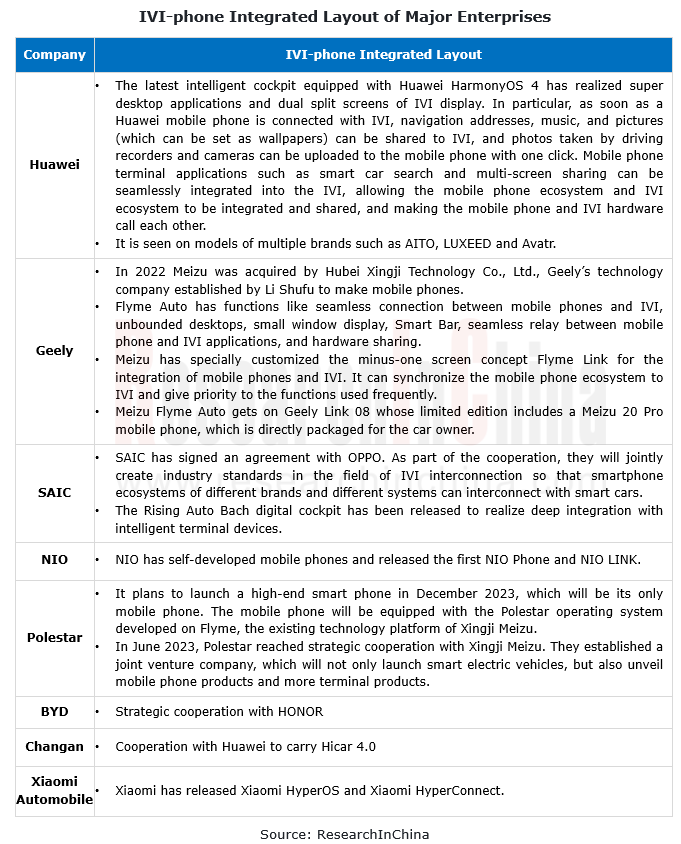
In November 2023, Chery and Huawei released their cooperative model LUXEED S7 whose cockpit is equipped with Huawei's new HarmonyOS 4.0. This intelligent cockpit brings a more powerful super desktop, and supports more applications to land on the car and call each other, greatly expanding its application scenarios.
Based on HarmonyOS 4.0, the intelligent cockpit of LUXEED S7 not only enables the most common entertainment connection, but also makes audio and video calls with Huawei mobile phones, tablet PCs, etc. It also supports the rapid transmission of navigation and entertainment information between devices, and easily controls a number of connected devices at home through comprehensive car-home interconnection capabilities, becoming a truly brand-new mobile smart device besides mobile phones and tablet PCs.
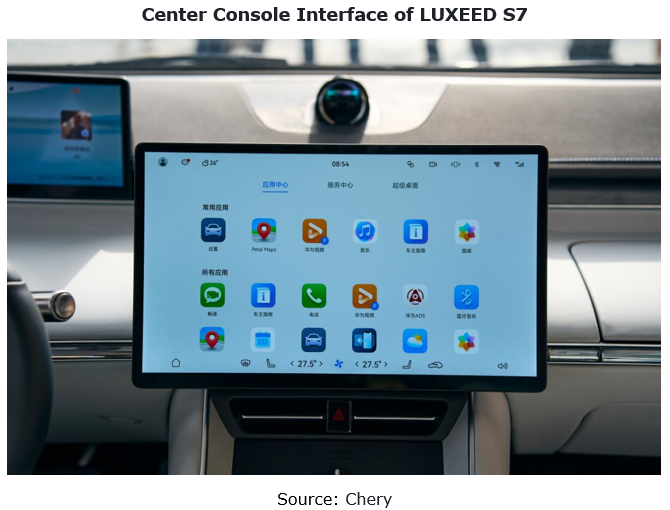
In October 2023, Xiaomi released the Xiaomi HyperOS, which aims to create a people-centric "ecological" operating system covering humans, cars and homes. Also Xiaomi has developed Xiaomi HyperConnect to make devices connect efficiently and cooperate excellently. With HyperOS, devices can be networked dynamically in real time.
Xiaomi HyperConnect connects the entire Xiaomi HyperOS ecosystem. Each device is like a tentacle that perceives the world, and they are connected together to form a huge network to ultimately forge a smart world of "human-car-home ecosystem". Users can see the devices in the control center, make the devices cooperate with each other without connection, and call the hardware capabilities of other devices in real time. For example, the menu in the upper right corner of the Xiaomi mobile phone has a separate control module designed for the car. The Xiaomi mobile phone can connect to Car WiFi. When the car owner is about to arrive home, his/her family can check the specific arrival information via the Xiaomi TV. The car owner can turn on the in-car camera and make video calls with his/her mobile phone. Xiaomi HyperOS features clear picture quality and extremely low latency, and also supports users to copy text, pictures, files, etc. across devices.
In the future, smart car user experience design will be further integrated with other platforms and devices. Users can seamlessly connect smart phones, smart homes and other devices with smart cars to achieve cross-platform integrated control and interaction. This design trend can provide more consistent and convenient user experiences. The integration of cross-terminal devices allows for the layout of home-car-office integration and other integrated scenarios.
Autonomous Driving Domain Controller and Central Computing Unit (CCU) Industry Report, 2025
Research on Autonomous Driving Domain Controllers: Monthly Penetration Rate Exceeded 30% for the First Time, and 700T+ Ultrahigh-compute Domain Controller Products Are Rapidly Installed in Vehicles
L...
China Automotive Lighting and Ambient Lighting System Research Report, 2025
Automotive Lighting System Research: In 2025H1, Autonomous Driving System (ADS) Marker Lamps Saw an 11-Fold Year-on-Year Growth and the Installation Rate of Automotive LED Lighting Approached 90...
Ecological Domain and Automotive Hardware Expansion Research Report, 2025
ResearchInChina has released the Ecological Domain and Automotive Hardware Expansion Research Report, 2025, which delves into the application of various automotive extended hardware, supplier ecologic...
Automotive Seating Innovation Technology Trend Research Report, 2025
Automotive Seating Research: With Popularization of Comfort Functions, How to Properly "Stack Functions" for Seating?
This report studies the status quo of seating technologies and functions in aspe...
Research Report on Chinese Suppliers’ Overseas Layout of Intelligent Driving, 2025
Research on Overseas Layout of Intelligent Driving: There Are Multiple Challenges in Overseas Layout, and Light-Asset Cooperation with Foreign Suppliers Emerges as the Optimal Solution at Present
20...
High-Voltage Power Supply in New Energy Vehicle (BMS, BDU, Relay, Integrated Battery Box) Research Report, 2025
The high-voltage power supply system is a core component of new energy vehicles. The battery pack serves as the central energy source, with the capacity of power battery affecting the vehicle's range,...
Automotive Radio Frequency System-on-Chip (RF SoC) and Module Research Report, 2025
Automotive RF SoC Research: The Pace of Introducing "Nerve Endings" such as UWB, NTN Satellite Communication, NearLink, and WIFI into Intelligent Vehicles Quickens
RF SoC (Radio Frequency Syst...
Automotive Power Management ICs and Signal Chain Chips Industry Research Report, 2025
Analog chips are used to process continuous analog signals from the natural world, such as light, sound, electricity/magnetism, position/speed/acceleration, and temperature. They are mainly composed o...
Global and China Electronic Rearview Mirror Industry Report, 2025
Based on the installation location, electronic rearview mirrors can be divided into electronic interior rearview mirrors (i.e., streaming media rearview mirrors) and electronic exterior rearview mirro...
Intelligent Cockpit Tier 1 Supplier Research Report, 2025 (Chinese Companies)
Intelligent Cockpit Tier1 Suppliers Research: Emerging AI Cockpit Products Fuel Layout of Full-Scenario Cockpit Ecosystem
This report mainly analyzes the current layout, innovative products, and deve...
Next-generation Central and Zonal Communication Network Topology and Chip Industry Research Report, 2025
The automotive E/E architecture is evolving towards a "central computing + zonal control" architecture, where the central computing platform is responsible for high-computing-power tasks, and zonal co...
Vehicle-road-cloud Integration and C-V2X Industry Research Report, 2025
Vehicle-side C-V2X Application Scenarios: Transition from R16 to R17, Providing a Communication Base for High-level Autonomous Driving, with the C-V2X On-board Explosion Period Approaching
In 2024, t...
Intelligent Cockpit Patent Analysis Report, 2025
Patent Trend: Three Major Directions of Intelligent Cockpits in 2025
This report explores the development trends of cutting-edge intelligent cockpits from the perspective of patents. The research sco...
Smart Car Information Security (Cybersecurity and Data Security) Research Report, 2025
Research on Automotive Information Security: AI Fusion Intelligent Protection and Ecological Collaboration Ensure Cybersecurity and Data Security
At present, what are the security risks faced by inte...
New Energy Vehicle 800-1000V High-Voltage Architecture and Supply Chain Research Report, 2025
Research on 800-1000V Architecture: to be installed in over 7 million vehicles in 2030, marking the arrival of the era of full-domain high voltage and megawatt supercharging.
In 2025, the 800-1000V h...
Foreign Tier 1 ADAS Suppliers Industry Research Report 2025
Research on Overseas Tier 1 ADAS Suppliers: Three Paths for Foreign Enterprises to Transfer to NOA
Foreign Tier 1 ADAS suppliers are obviously lagging behind in the field of NOA.
In 2024, Aptiv (2.6...
VLA Large Model Applications in Automotive and Robotics Research Report, 2025
ResearchInChina releases "VLA Large Model Applications in Automotive and Robotics Research Report, 2025": The report summarizes and analyzes the technical origin, development stages, application cases...
OEMs’ Next-generation In-vehicle Infotainment (IVI) System Trends Report, 2025
ResearchInChina releases the "OEMs’ Next-generation In-vehicle Infotainment (IVI) System Trends Report, 2025", which sorts out iterative development context of mainstream automakers in terms of infota...